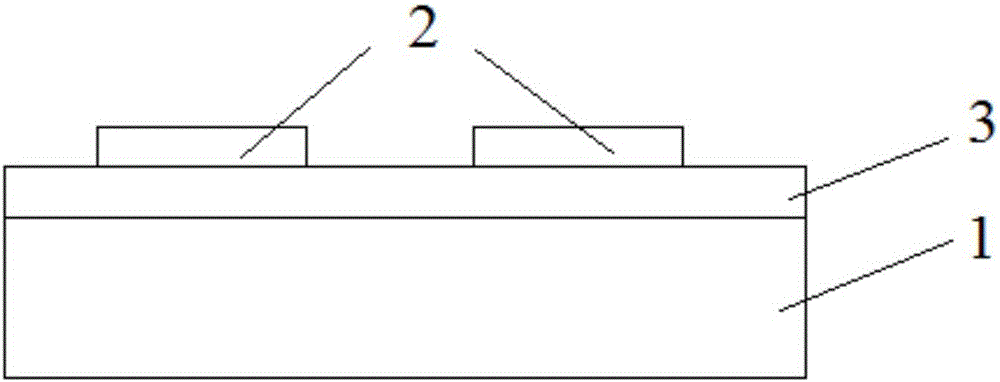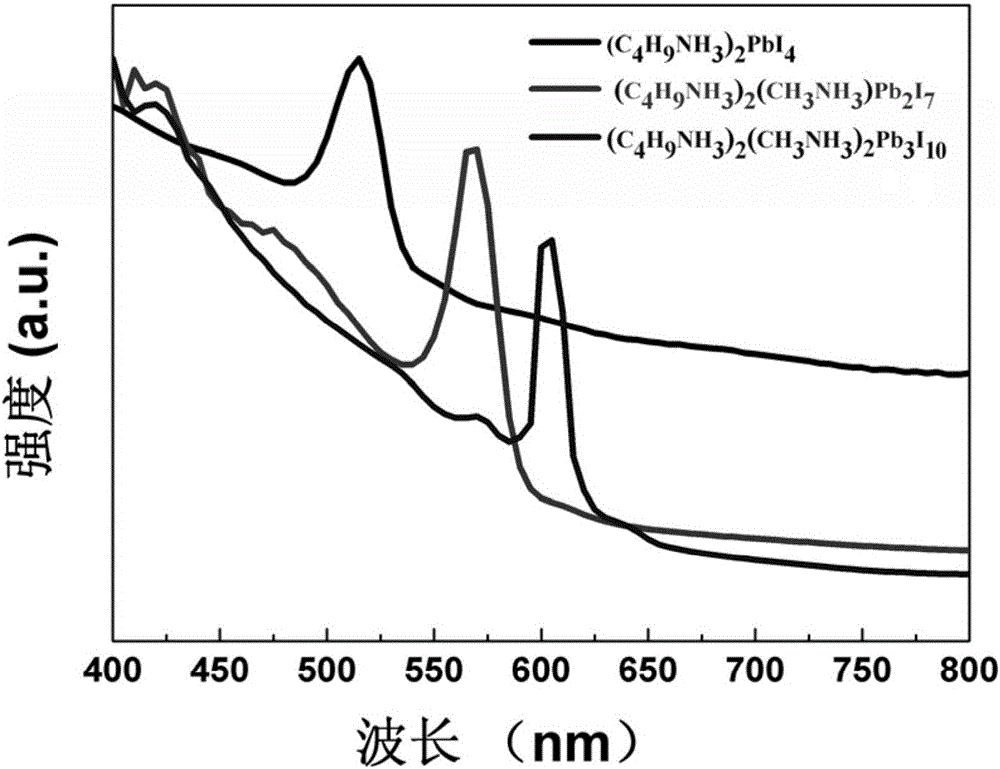Two-dimensional layered organic-inorganic composite perovskite material optical detector and manufacturing method thereof
A perovskite material and composite perovskite technology, which is applied in semiconductor/solid-state device manufacturing, photovoltaic power generation, electric solid-state devices, etc., can solve problems such as poor detection ability, and achieve easy portability, simple preparation process, and low cost Effect
- Summary
- Abstract
- Description
- Claims
- Application Information
AI Technical Summary
Problems solved by technology
Method used
Image
Examples
Embodiment 1
[0040] The two-dimensional layered organic-inorganic perovskite series materials are prepared according to the following steps (in this embodiment, M is Pb, X is I, n=1, 2, 3 as an example to illustrate but not limited to this):
[0041] Step 1. All purchased chemical reagents are of analytical grade. 11.86ml of n-butylamine (mass fraction greater than 99%) was added to a 100ml round bottom flask, and 13.43ml of hydroiodic acid (mass fraction of 55%) was added dropwise. After the mixed solution was reacted in an ice bath for 2 hours, the excess solvent was evaporated to dryness using a rotary evaporator. The crude product obtained by rotary evaporation was placed in a Buchner funnel and washed with anhydrous ether for at least three times to remove possible iodine element. The white solid obtained by suction filtration is placed in a vacuum drying oven at 60 ° C and dried overnight to obtain pure butylamine iodide (C 4 H 9 NH 3 i).
[0042] In step 2, all purchased chemic...
Embodiment 2
[0045] The photodetector prepared by this technology comprises, from bottom to top, a substrate 1, a photosensitive layer 3 and a gold thin film 2 forming a source electrode and a drain electrode, such as Figure 1-2 shown. The substrate 1 is a glass substrate, and may also be made of other insulating materials with flat surfaces (such as silicon wafers, quartz, etc.). The electrodes can be made of various metals such as gold and silver. In this technology, the electrodes are made of gold electrodes by vacuum thermal evaporation and physical vapor deposition.
[0046] The first step is to ultrasonically clean the substrate with acetone and isopropanol for 30 minutes each, then rinse with deionized water and alcohol, and dry the surface of substrate 1 with nitrogen;
[0047] In the second step, the cleaned glass substrate is placed in a plasma processor for 10 minutes, and the energy is high-level;
[0048] The third step is to put the surface-hydrophilized glass substrate in...
Embodiment 3
[0052] The organic-inorganic composite perovskite series materials used in this technology are C 4 h 9 NH 3 I. CH 3 NH 3 I and PbI 2 According to the ratio of 2:0:1, 2:1:2 and 2:2:3, they were dissolved in N, N-dimethylformamide and spin-coated. During the process of spin-coating to prepare thin films, CH 3 NH 3 + will enter PbI 2 the interior of the lattice, while C 4 h 9 NH 3 + Due to the large volume, the PbI 2 The original three-dimensional crystal structure is divided into two-dimensional layered structure, and the C at different concentrations 4 h 9 NH 3 + The number of layers of the inorganic layer can be controlled, and the number of layers corresponding to the above three ratios is n=1, 2 and 3 (n represents the nonpolar layer [PbI 6 ] 4- layers). During the self-assembly process, the C 4 h 9 NH 3 + connected by weak intermolecular forces.
PUM
 Login to View More
Login to View More Abstract
Description
Claims
Application Information
 Login to View More
Login to View More - R&D
- Intellectual Property
- Life Sciences
- Materials
- Tech Scout
- Unparalleled Data Quality
- Higher Quality Content
- 60% Fewer Hallucinations
Browse by: Latest US Patents, China's latest patents, Technical Efficacy Thesaurus, Application Domain, Technology Topic, Popular Technical Reports.
© 2025 PatSnap. All rights reserved.Legal|Privacy policy|Modern Slavery Act Transparency Statement|Sitemap|About US| Contact US: help@patsnap.com



